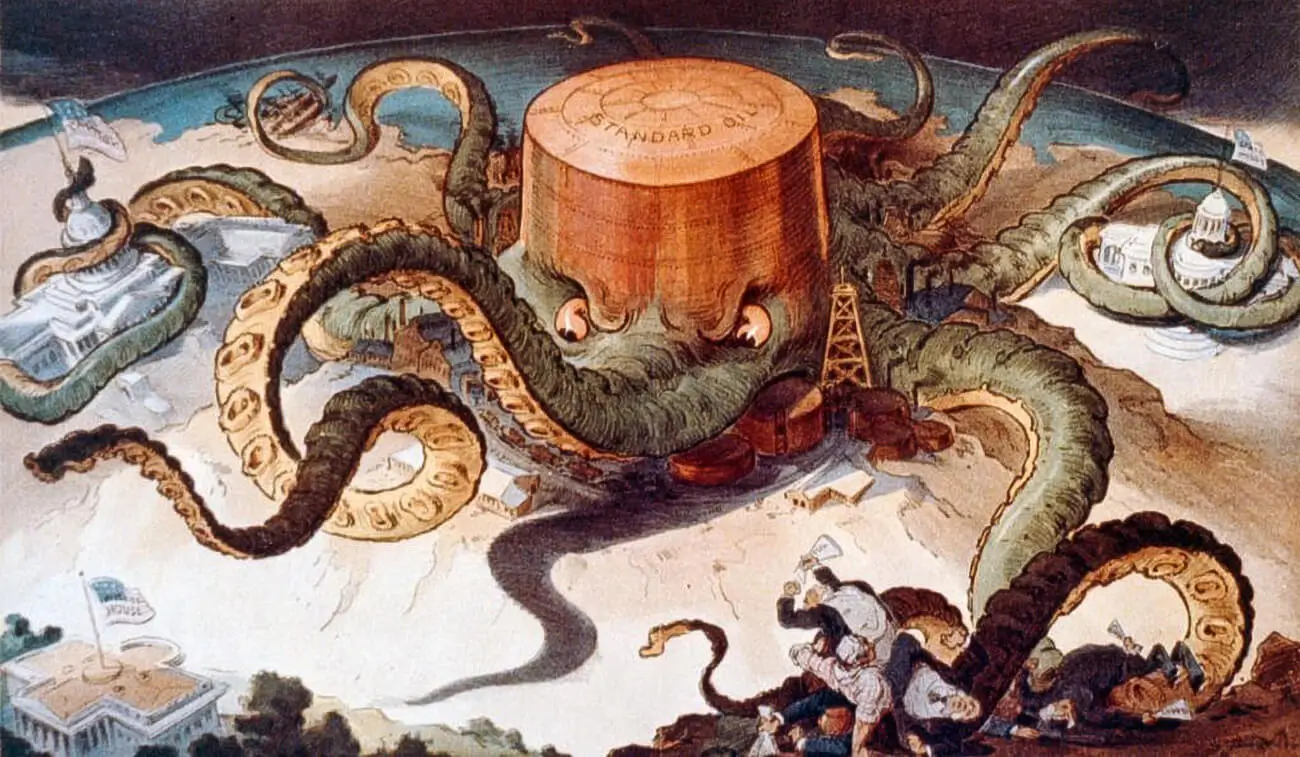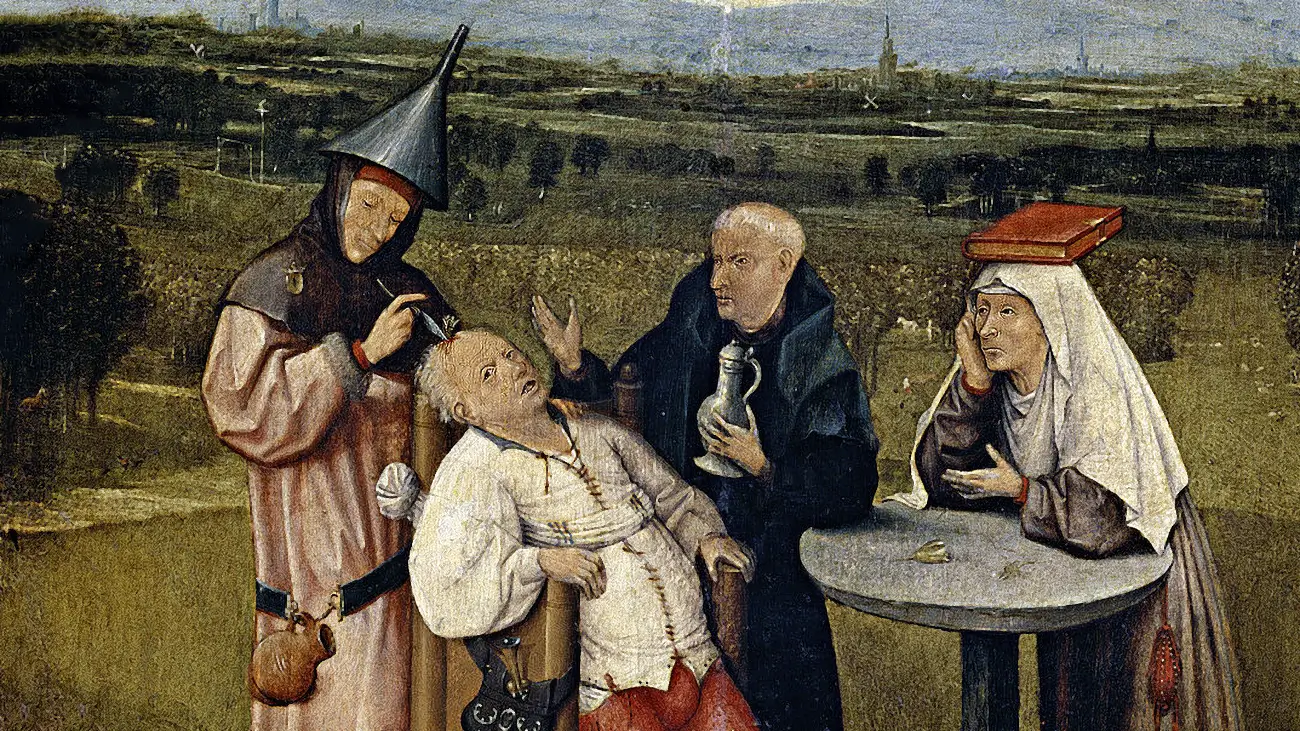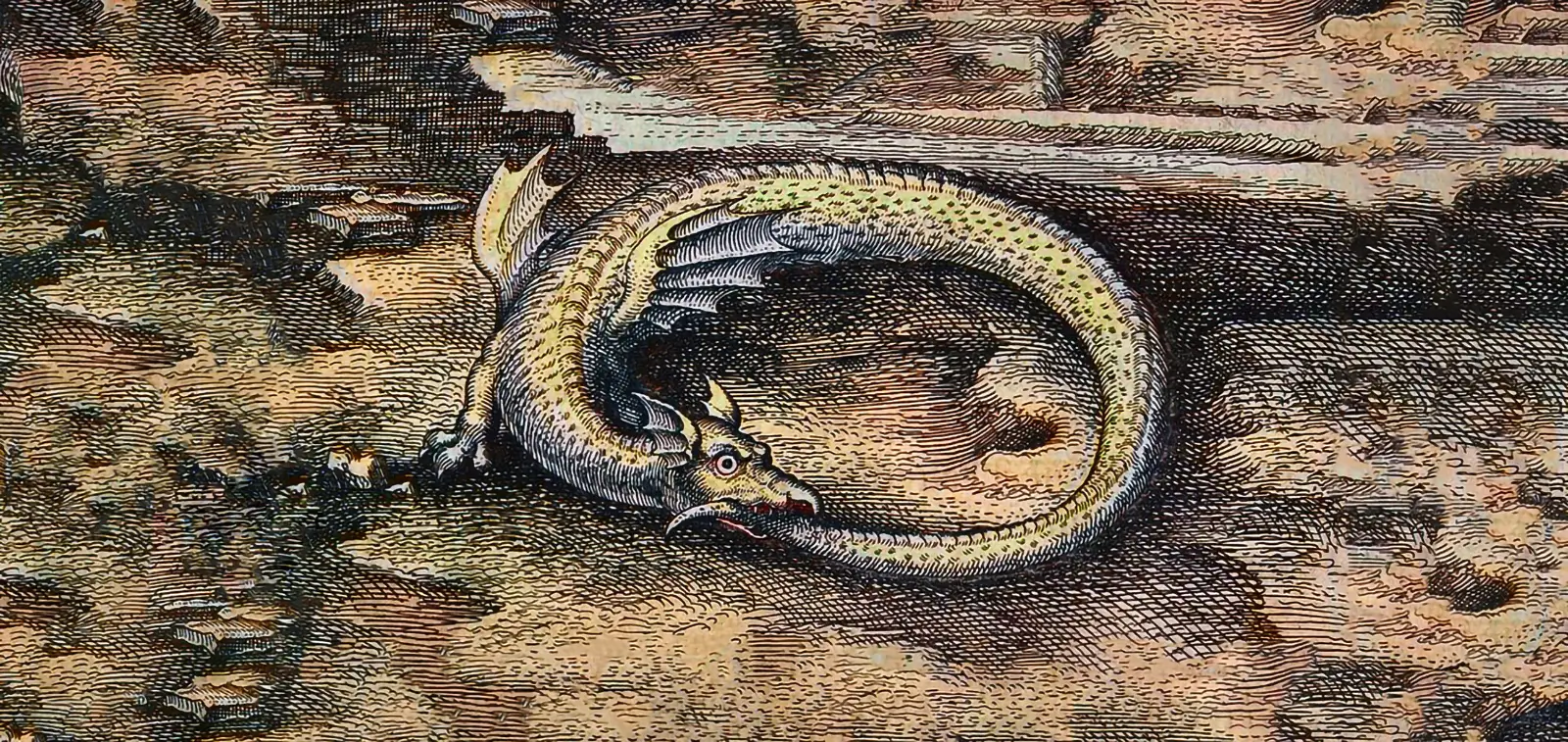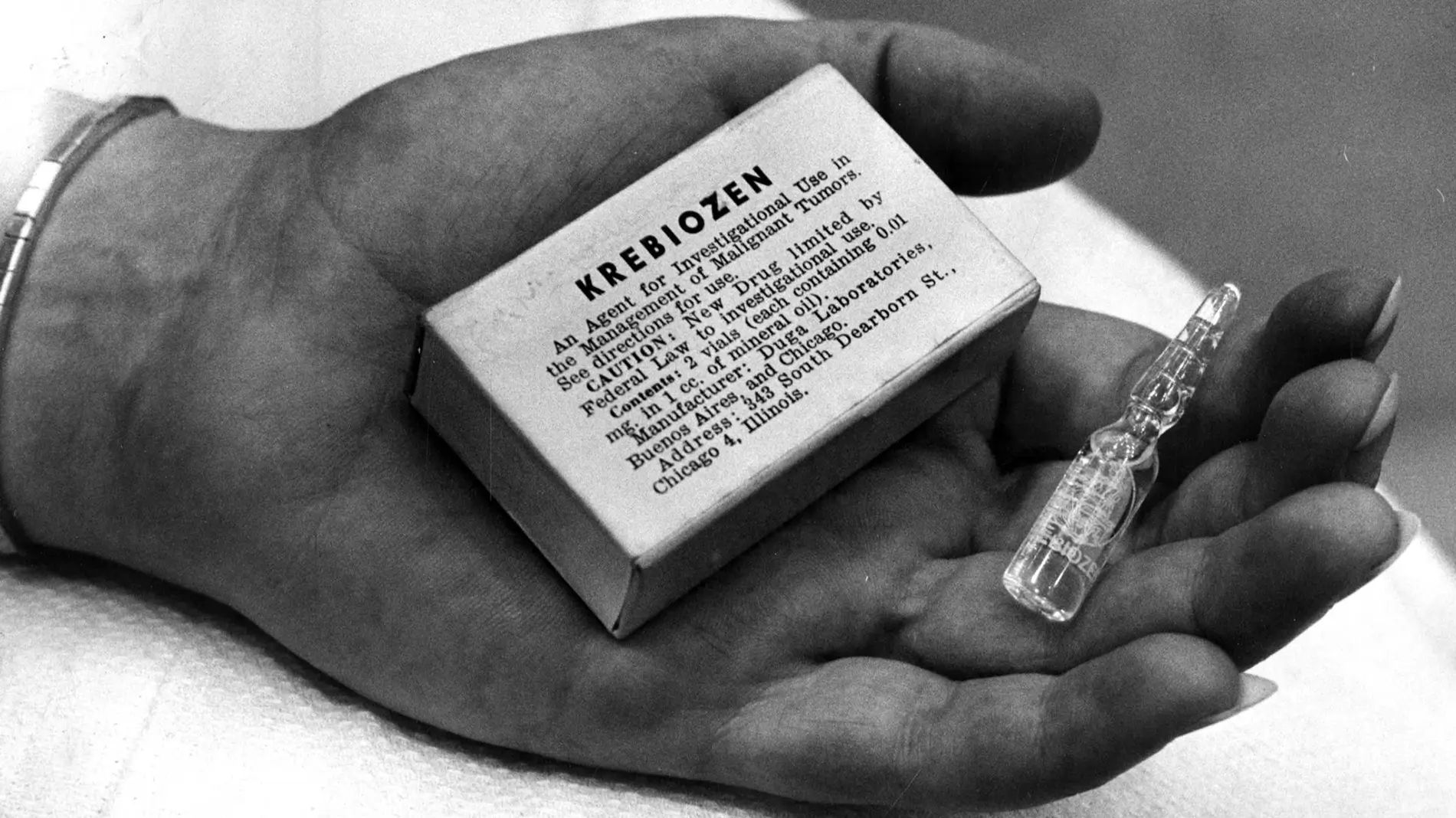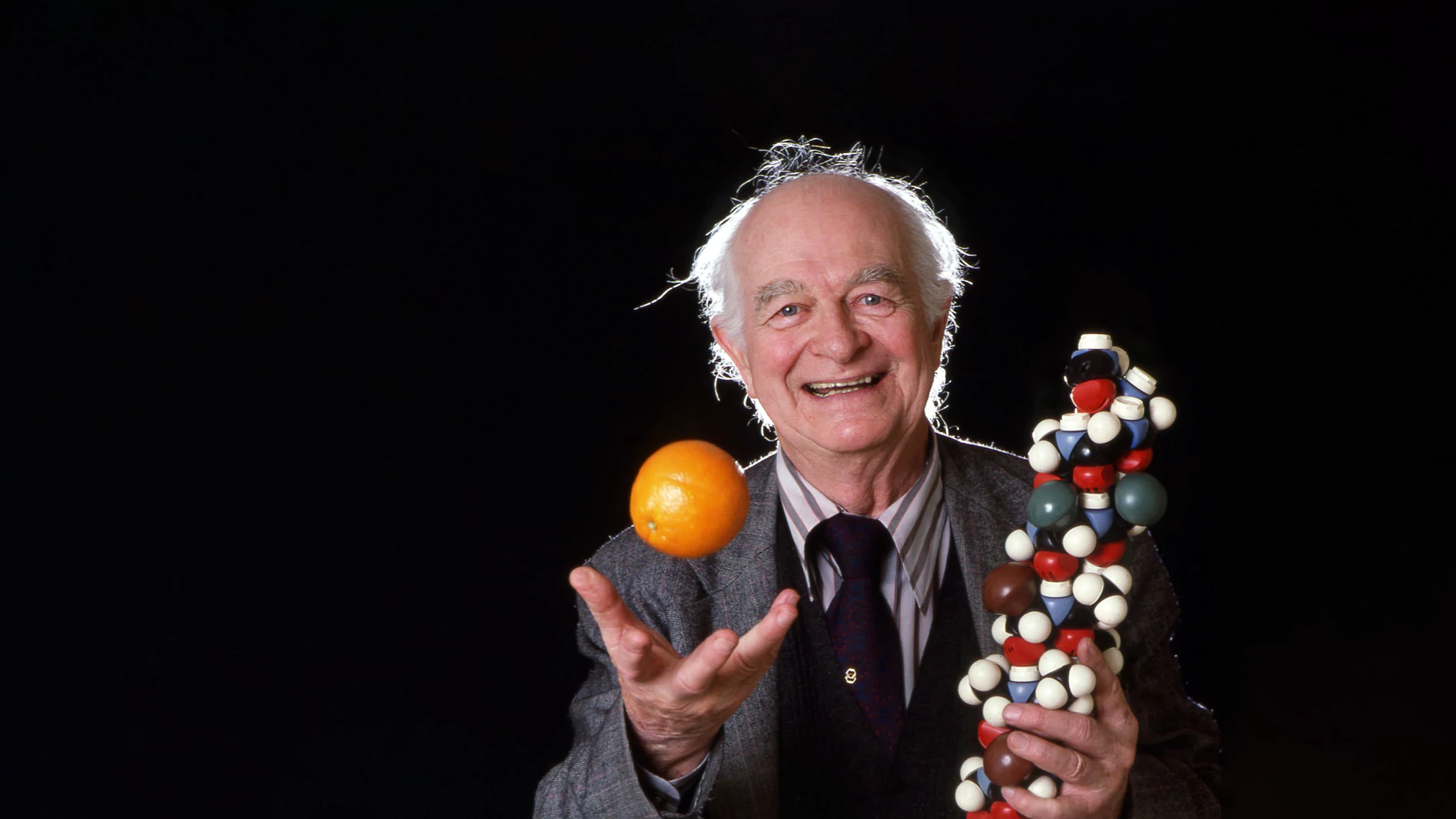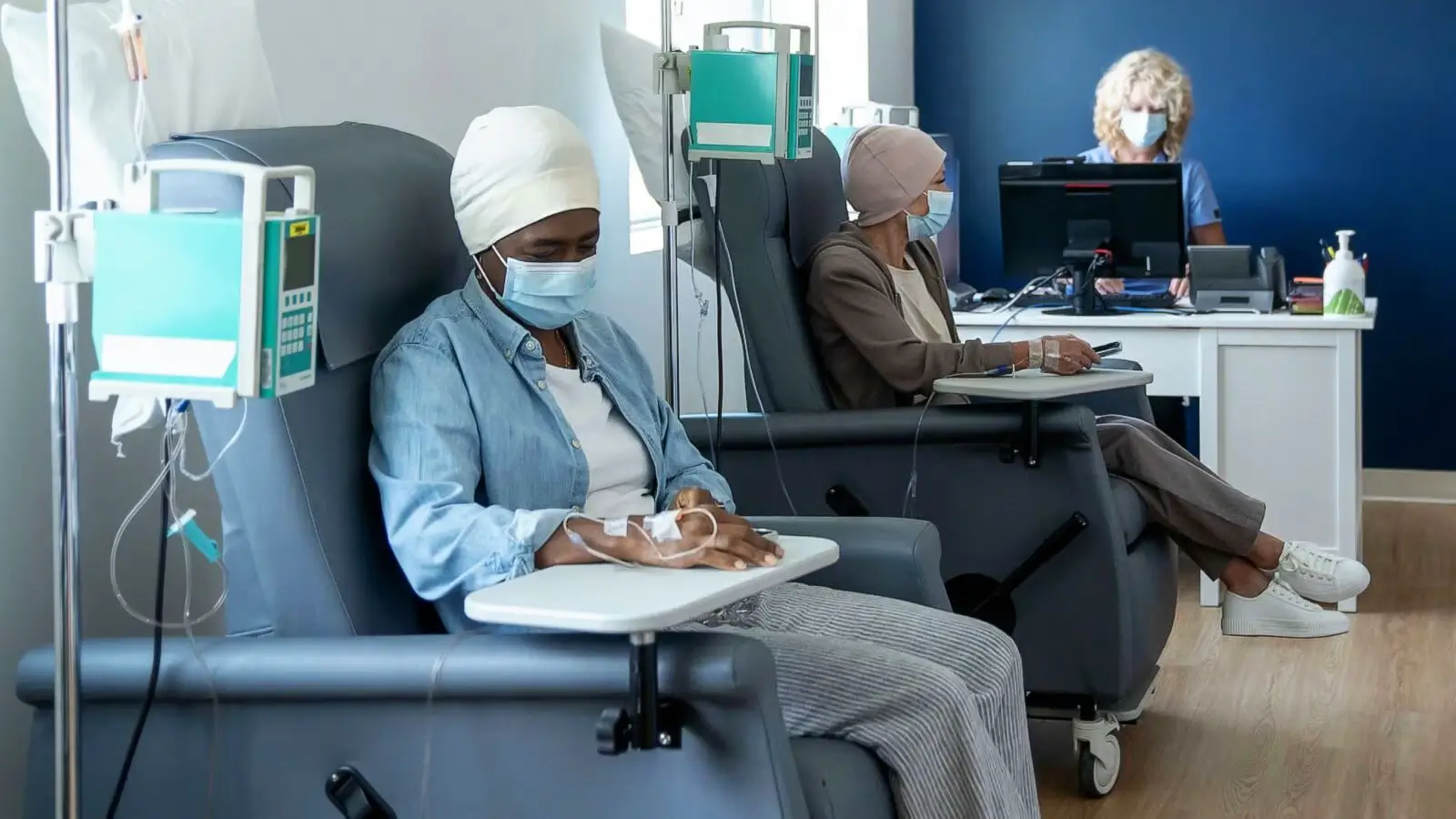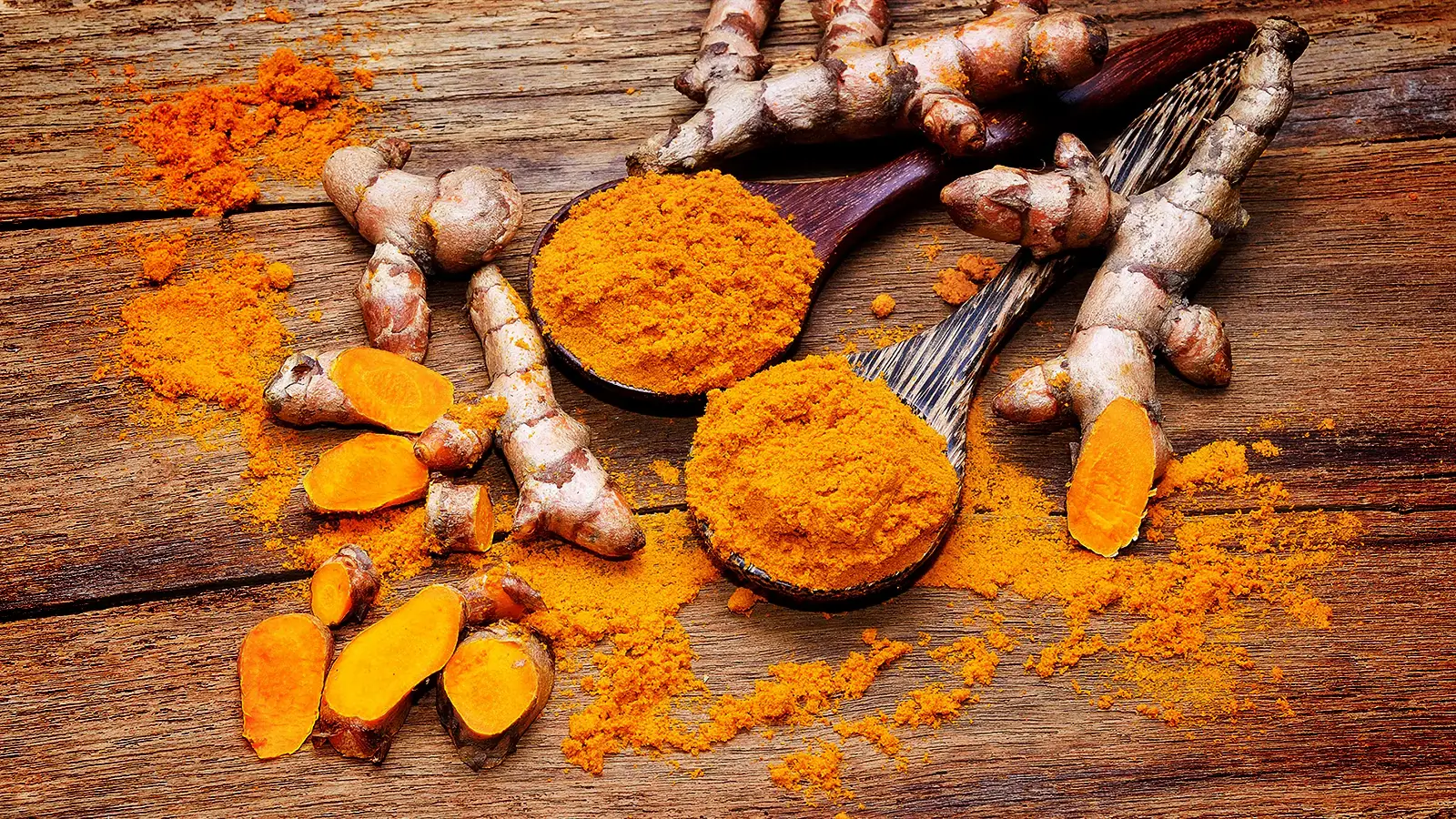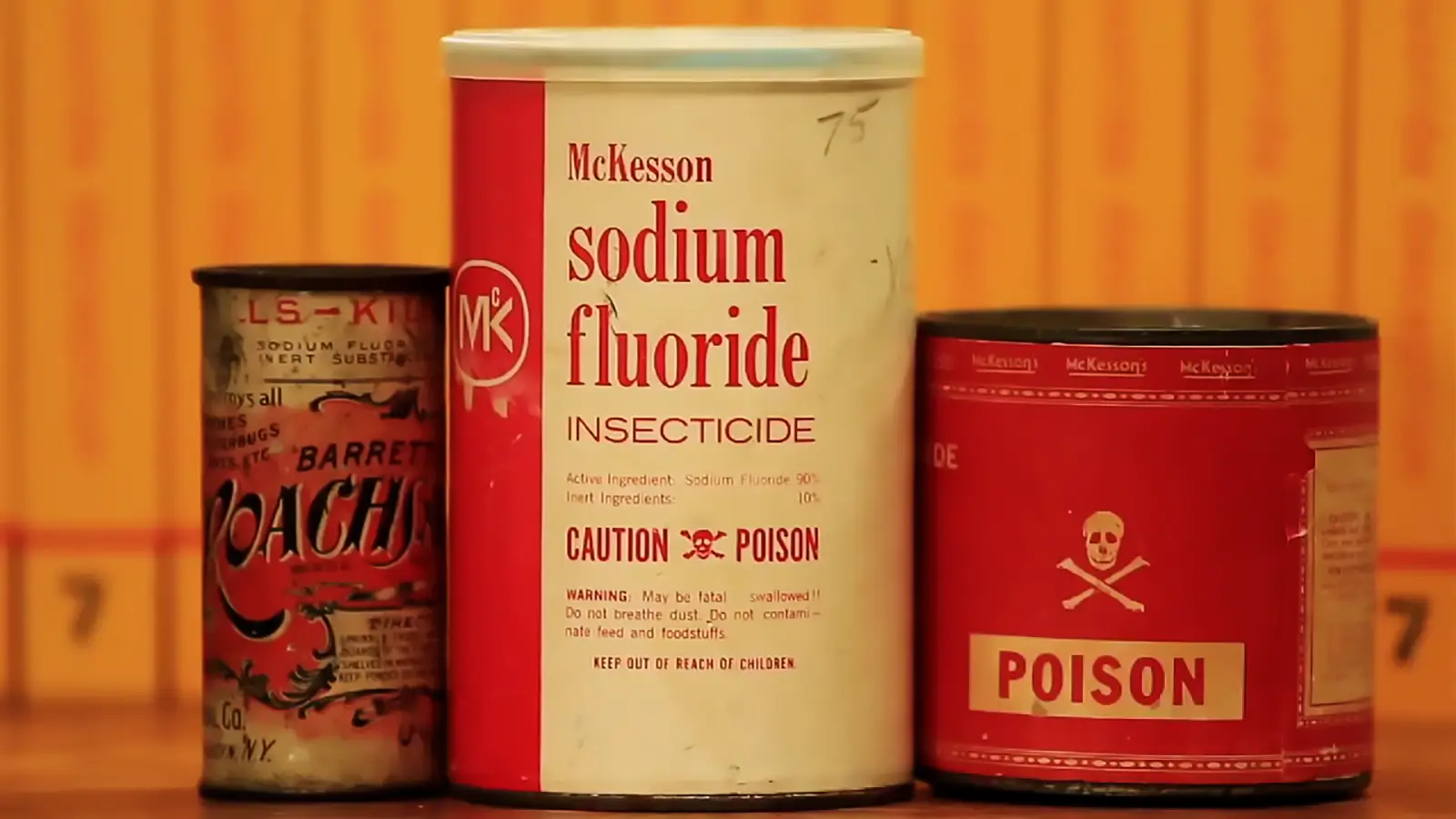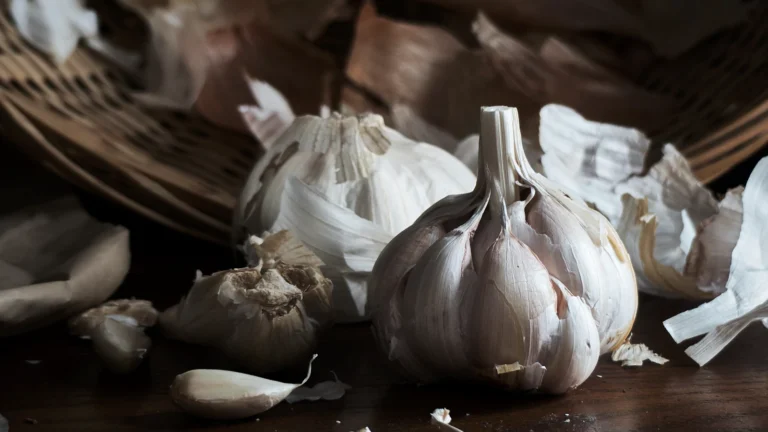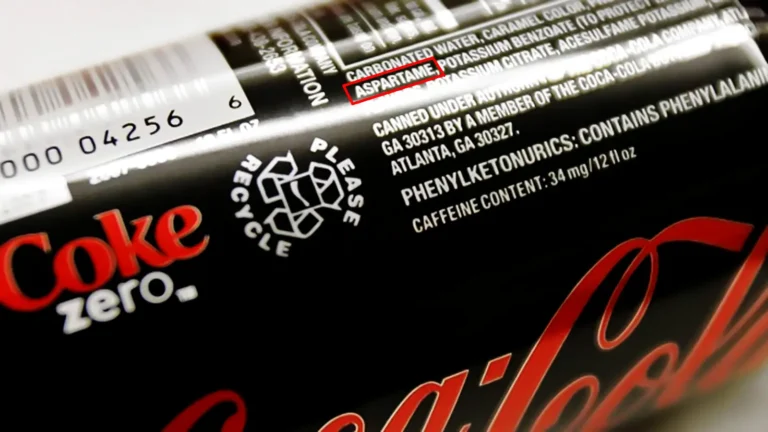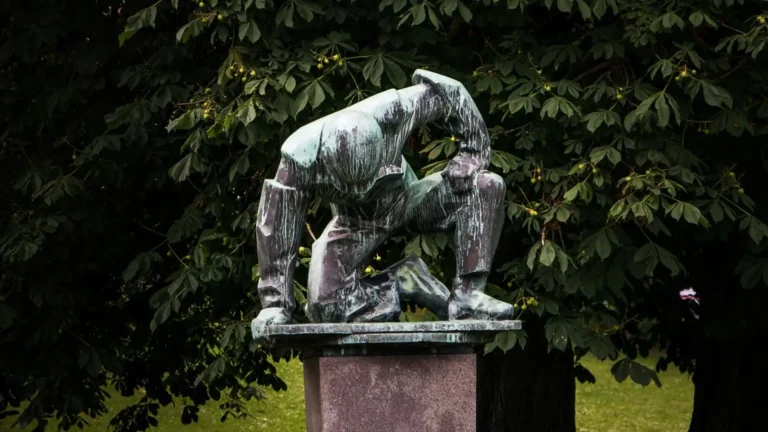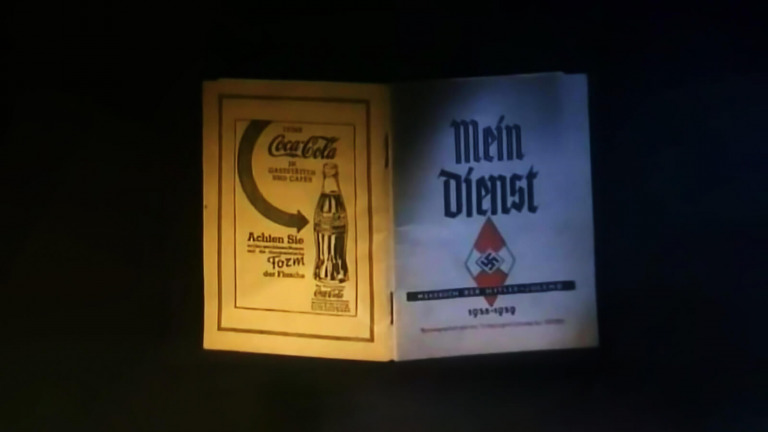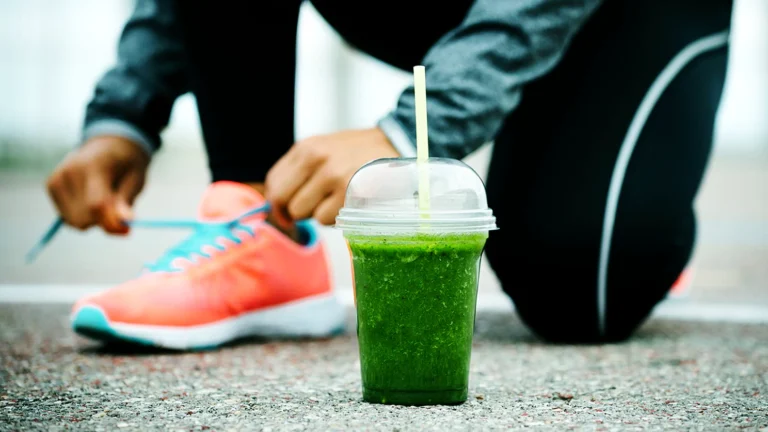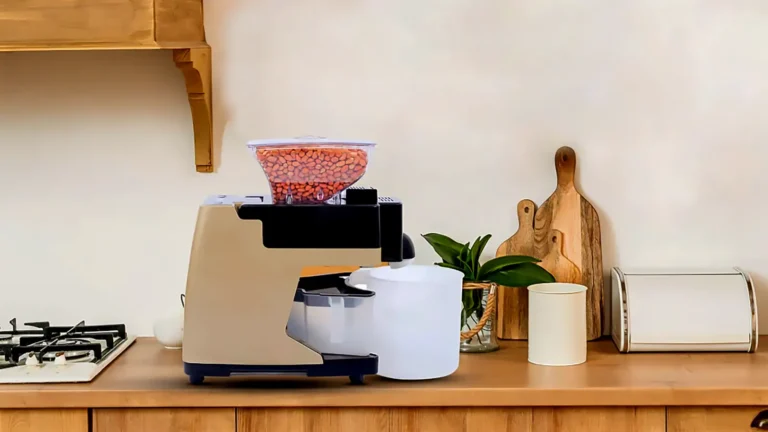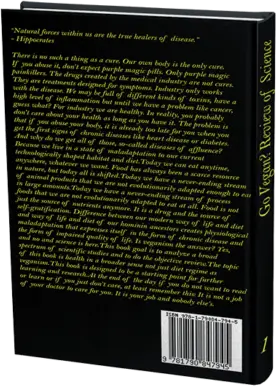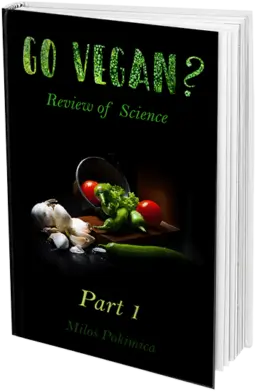Krebs, die Verbotenen Heilmittel- ESSIAC
Essiac ist billig. Essiac ist ungiftig. Essiac ist wirksam. Essiac kann nicht patentiert werden.
Milos Pokimica
Geschrieben von: Milos Pokimica
Medizinisch Begutachtet Von: Dr. Xiùying Wáng, M.D.
Aktualisiert am 28. Mai 2023Die Wahrheit ist falsch. Das ist orwellsche Doppelzüngigkeit. Die Verbindungen zwischen der Pharmaindustrie, elitären Bankenkartellen, denen diese Industrie gehört, medizinischen Einrichtungen und Regierungen haben die Agenda nicht nur vorangetrieben, um mehr Geld zu verdienen, sondern auch die menschliche Existenz als Ganzes zu beherrschen. Heute ist es soweit, dass es unter dem Dach der UN durchgesetzt wird.
Einer der bodenständigen und nicht so „philosophischen“ Aspekte der Agenda ist die systematische Zerstörung der Naturgesundheitsindustrie und der Zugang zu natürlichen Nahrungsergänzungsmitteln als letzter Schlag in einem Krieg gegen Pflanzen, der seit mehr als 100 Jahren andauert. Und nicht nur Pflanzen sind ein Problem, weil sie nicht patentierbar sind. Es geht nicht um Geld. Es ist mehr als das. Jedes wirkliche Heilmittel, das die Krankheit in ihren Wurzeln zerstört, ist nicht etwas, was die Industrie will, selbst wenn es patentiert werden könnte. Sie wollen keine Heilung, sondern nur Behandlungen, die das Leben ein wenig verlängern können. Schauen wir uns Beispiele aus der Praxis an.
In einer kleinen Stadt im Norden Ontarios kursierten 1922 Gerüchte über einen krebsheilenden Tee, der aus den Wäldern Ontarios stammen sollte. Der kanadische Ojibwa-Stamm verwendete ursprünglich eine Mischung. Die Indianer nannten diese Mischung den "Tee des Lebens". An einem schicksalhaften Tag im Jahr 1922 bemerkte der kanadische Krebsarzt Rene Caisse Narbengewebe auf der Brust einer älteren englischen Frau.
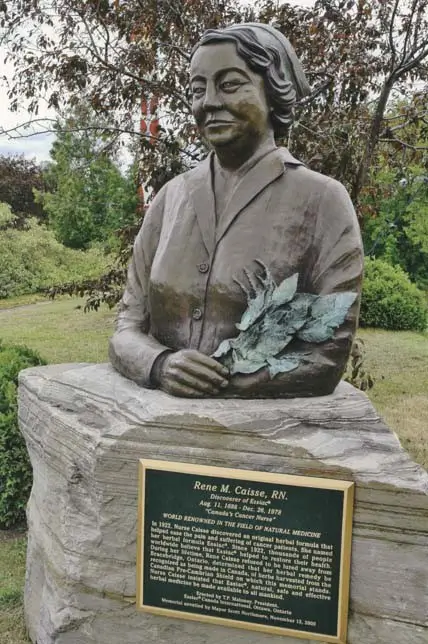
Bei ihr wurde vor 30 Jahren Brustkrebs diagnostiziert, und sie hat ihn auf natürliche Weise und ohne Operation geheilt, und das sollte nicht möglich sein, nicht einmal heute. Die Frau hatte einfach nicht das Geld dafür. Sie traf einen indianischen Medizinmann, der ihr erzählte, dass in der Tradition seines Stammes die Krankheit mit etwas Tee geheilt werden kann.
Nun, die Frau hatte nichts zu verlieren. Also probierte sie den Tee und es half ihr. Sie lebte 30 Jahre später noch, als Krankenschwester Caissie sie untersuchte.
Sie teilte der Krankenschwester auch die Inhaltsstoffe des Kräutermittels mit. Ein Jahr später unternahm die Krankenschwester Caissie immer noch nichts wegen des Tees, von dem sie erzählte, aber ein örtlicher Arzt sagte ihr bei einem Spaziergang, dass es keinen Brustkrebs mehr geben würde, wenn die Welt ein Kraut verwenden würde, das sie gerade dort vorbeigebracht hatten. Es war eines der Unkräuter, die in dem Tee des indischen Medizinmanns enthalten waren.
Das "Unkraut" war Schafsklee.
Im Jahr 1924 beschloss sie, den Tee an ihrer Tante zu testen. Ihre Tante hatte nichts zu verlieren, da sie an Magenkrebs erkrankt war und die Schulmedizin ihr damals etwa sechs Monate zu leben gab. Sie lebte weitere 21 Jahre ohne Krebs. Rene Caisse (ausgesprochen "Reen Case") gab den Tee später ihrer 72-jährigen Mutter, bei der ein inoperabler Leberkrebs diagnostiziert wurde und die nur noch wenige Wochen zu leben hatte. Ihre eigene Mutter wurde geheilt und lebte weitere 18 Jahre ohne Krebs. Nach diesen Ereignissen beschloss Schwester Caisse, das Krankenhaus zu verlassen und begann, Menschen mit einer Kräutermischung zu heilen, die unter dem Namen Essiac bekannt wurde - ihr Nachname ist rückwärts buchstabiert.
Bald verbreitete sich die Stimme und die Zahl der Patienten begann zu wachsen. Als Dr. Bestida aus Bracebridge, Ontario, Cassie seinen Patienten Bert Rosin schickte, heilte sie ihn und Dr. Bestida ging vor den Stadtrat und einen Bürgermeister und überredete sie, der Krankenschwester Caisse das Gebäude als Klinik zu überlassen. Also gründeten sie die Klinik, weil Cassie eine großartige Entdeckung gemacht hatte und sie wollten, dass ihre eigene Heimatstadt sie unterstützte.
Achteinhalb Jahre lang behandelte sie dort Patienten, die aus allen Himmelsrichtungen herbeiströmten. Sie behandelte etwa sechshundert Patienten pro Woche, und die einzige Möglichkeit, dies zu tun, war, dass sie es kostenlos tun durfte und dass sie für jeden Fall, den sie behandelte, eine ärztliche Diagnose vorlegen musste. Stellen Sie sich nun vor, wir würden der heutigen Krebsindustrie dieselben Regeln auferlegen.
Es war jedoch ein Dr. Leonardo aus Buffalo, der das Potenzial dieses Krebsheilmittels sofort erkannt hatte, der sie vor dem, was passieren wird, warnte. Er war Krebschirurg und fragte, ob er in die Klinik gehen und Patienten untersuchen könne, um sich selbst ein Bild zu machen. Nachdem er sich selbst davon überzeugt hatte, sagte er zu Cassie, dass sie es (das Heilmittel) hat, aber die Ärzteschaft wird ihr das niemals erlauben. Einige Zeit nach seinem Besuch tauchte eine kleine Gruppe mysteriöser "Unternehmer" auf und bot Cassie eine kleine Summe von einer Million Dollar für die Geheimformel an. Zu dieser Zeit war eine Million eine große Summe Geld. Das entspricht heute 20 Millionen. Heute können wir uns das als Bestechung vorstellen, damit sie schweigt und sich an einem warmen und schönen Ort zur Ruhe setzt. Was diese Leute nicht garantieren wollten, war, dass ihr Heilmittel den Menschen, die es brauchten, kostenlos oder überhaupt zur Verfügung gestellt werden würde. Sie wollten nur, dass die Formel und sie selbst verschwinden. Der einzige Grund, warum wir heute davon wissen und Sie darüber lesen können, ist, dass sie sich weigerte. Sie war emotional und nicht pragmatisch. Sie hat die Menschen in der Klinik kostenlos behandelt. Hätten Sie ein solches Angebot abgelehnt? Wer bei klarem Verstand würde das tun? Wie viele andere Heilungen sind durch diese Form der Bestechung unterdrückt worden, von denen wir nichts wissen und die wir nie erfahren würden?
Im Jahr 1938 wurde ihr Fall vor die Legislative gebracht, um den rechtlichen Status von Essiac zu klären. Sie versuchte, ihre Behandlung zu legalisieren. Ihre Patienten sammelten 55.000 Unterschriften für eine Petition. Ein Gesetzesentwurf wurde in die Legislative von Ontario eingebracht, um (angeblich) "Rene Caisse die Erlaubnis zu erteilen, in der Provinz Ontario als Arzt für die Behandlung von Krebs und anderen Krankheiten zu praktizieren." Der Gesetzentwurf wurde nicht angenommen. Der Zorn der Öffentlichkeit erzwang die Einsetzung einer Krebskommission, die ihre Heilmittel untersuchen sollte, aber alles wurde abgelehnt. Rene Caisse behandelte ihre Patienten unter der Aufsicht vieler Ärzte. Einige dieser Ärzte sahen mit eigenen Augen, was dieser Tee bewirken konnte, und acht von ihnen unterzeichneten eine Petition an das Ministerium für Gesundheit und Wohlfahrt in Ottawa, in der sie darum baten, Schwester Caisse die Möglichkeit zu geben, unabhängige Forschungen über ihre Entdeckung durchzuführen. Anfänglich war Rene nicht bekannt, welche Kontrolle die medizinische/pharmazeutische Industrie über die Regierungen ausübt. Nach der Übergabe der Petition wurde sie ständig mit Verhaftung bedroht, bis sie sich schließlich aus der Öffentlichkeit zurückzog. Sie hielt ihre Klinik so lange aufrecht, wie sie konnte, bis die Ärzte keine Diagnosen mehr stellen durften und sie gezwungen war, aufzuhören. Die Patienten kamen weiterhin und baten sie in einigen Fällen, sie zu behandeln, aber ohne Diagnose konnte sie das nicht tun, weil sie sonst für lange Zeit ins Gefängnis geworfen worden wäre. Sie erlitt einen Nervenzusammenbruch und schloss die Klinik.
Essiac war billig. Essiac ist ungiftig. Essiac kann nicht patentiert werden.
Sie lehnte das Bestechungsgeld ab.
In der normalen Welt würde eine solche Entdeckung mit offenen Armen begrüßt und es würden umfangreiche Untersuchungen durchgeführt, um herauszufinden, wie Krebs unterdrückt werden kann. In dieser Welt voller Korruption werden solche Dinge als gefälscht und gefährlich abgestempelt, und in diesem Fall konnten die Massenmedien von Konzernen Schwester Cassie nicht verteufeln, weil sie kein Geld für die Behandlung verlangte. Also haben sie die Klinik einfach stillschweigend abgeschossen und sie als gefälschtes Krebsheilmittel abgestempelt, das die Menschen meiden sollten, ohne dass irgendwelche Nachforschungen angestellt wurden. Zu diesem Zeitpunkt erhielt sie eine Diagnose von regulären Ärzten. Sie hatte pathologische Befunde und Tausende lebender Patienten, die aus den regulären Krankenhäusern entlassen und zum Sterben nach Hause geschickt wurden. Sie kamen im Endstadium der Krebserkrankung zu ihr und lebten weiter, nachdem die Ärzteschaft sie aufgegeben hatte.
Bis heute stellt die American Cancer Society Folgendes fest:
"Überprüfungen von Krankenakten von Menschen, die mit Essiac behandelt wurden, stützen nicht die Behauptung, dass dieses Produkt Menschen mit Krebs hilft, länger zu leben oder dass es ihre Symptome lindert", und die FDA bezeichnete Essiac als ein "gefälschtes Krebs-'Heilmittel', das Verbraucher meiden sollten".
Cancer Research UK bemerkt außerdem Folgendes:
" Es gibt keine wissenschaftlichen Beweise dafür, dass Essiac bei der Behandlung von Krebs oder der Kontrolle seiner Symptome helfen kann" und warnt sogar davor, dass: "Essiac kann mit einigen Arten von Krebsbehandlungen interagieren, daher ist es sehr wichtig, dass Sie Ihren Arzt informieren, wenn Sie die Einnahme von Essiac erwägen."
Nachdem sie sich von dem Zusammenbruch erholt hatte, fing sie wieder an, die Kräutermischung in ihrem eigenen Keller zu brauen und eine kleine Anzahl von Patienten zu heilen. Schon bald wurde sie wieder von der Regierung schikaniert und mehrmals verhaftet. Aber die Geschichte wurde bekannt, und der Leibarzt von JFK, Dr. Charles Brusch, der auch mit ihm eng befreundet war und der sich selbst mit Essiac behandelte, als er gegen Krebs kämpfte, lud sie ein, Essiac wissenschaftlich zu testen. Caisse übergab einige Essiac-Proben an Dr. Charles Brusch, den Gründer des Brusch Medical Center in Cambridge, Massachusetts, wo die Tests durchgeführt wurden. Diese ersten wissenschaftlichen Tests zeigten, dass Essiac nicht giftig ist und positive Auswirkungen auf die Bekämpfung von Krebs hat. Damals empfahl Dr. Brusch, dass Essiac auf Toxizität getestet werden sollte, um von der FDA als mögliche Krebsbehandlung zugelassen zu werden.
Als dieser Tee im Sloan-Kettering Cancer Center ankam, geriet der Prozess irgendwie ins Stocken. Ein Labor am Memorial Sloan-Kettering Cancer Center testete in den 1970er Jahren Essiac-Proben (bereitgestellt von Caisse) an Mäusen. Diese Studie wurde nie offiziell veröffentlicht. Über die Ergebnisse gibt es Kontroversen. Es gab unerklärliche Verzögerungen und weitere Verzögerungen und Prozesse kamen nie zu einem Abschluss. Das Sloan-Kettering Cancer Center ist angeblich eines der wichtigsten Krebsforschungszentren in den USA. Chester Stock, der Co-Direktor von Sloan-Kettering, sagte in einem Interview mit der Nachrichtenagentur, dass die von ihm gemeldeten Ergebnisse zeigten, dass es in der kleinen Gruppe von Regressionen einen sehr kleinen Prozentsatz gebe, sie jedoch nie die Gelegenheit gehabt hätten, dies zu bestätigen um zu sehen, ob sie bessere Ergebnisse erzielen könnten.
Letztendlich wurde Essiac von der FDA nicht zugelassen. Caisse lehnte Angebote von Forschern des Memorial Sloan-Kettering und des US National Cancer Institute auf Zugang zu dem Rezept ab. Dies ging so weit, dass sich Patienten selbst mehrmals organisierten, um gegen die Regierung und die FDA zu klagen. Sie glaubten, dass sie sich laut Verfassung jede Substanz zuführen könnten, die sie wollen, solange sie keine Gefahr für andere darstellt und dass ihnen weder die FDA noch irgendjemand sonst vorschreiben könne, was sie in ihrem eigenen Körper verwenden dürfen und was nicht, also verschiedene Gruppen von Patienten organisierten und verklagten die FDA, weil sie ihnen eine mögliche Heilung verweigerte.
Gerichtsverhandlungen führten zu nichts, und ja, ihnen wurden verfassungsmäßige Rechte verweigert.
Dr. Frederick Banting, der Mitentdecker des Insulins, interessierte sich für Essiac und bot Schwester Caisse sogar Forschungseinrichtungen an, um es weiter zu testen, aber zu diesem Zeitpunkt hatte Rene bereits ihren Kampfeswillen verloren. Die einzige Frau, der Rene Caisse bei der Zubereitung von Essiac-Tee vertraute, war ihre beste Freundin Mary McPherson. Laut Dr. Gary Glum hatte Mary Rene versprochen, das Rezept niemals an andere weiterzugeben. Es war ein gewisser Dr. Glum, der 1985 die Formel für $120.000 von einem von Renes ehemaligen Patienten kaufte. Dr. Glum hätte die Formel geheim halten und mit dem Verkauf von Essiac-Flaschen sehr wohlhabend werden können. Er gab die Formel jedoch 1988 selbstlos an die Öffentlichkeit weiter. Zunächst bot er die Formel auf einem Videoband an, das er in seinem Buch bewarb, aber die Bundespolizei beschlagnahmte die Bänder unrechtmäßig, bevor er sehr viele davon verkaufen konnte. Dr. Glum verteilte die Essiac-Formel und das Rezept kostenlos an jeden, der ihm eine Anfrage für die Essiac-Formel schickte. Als Dr. Glum Mary McPherson in Bracebridge, Ontario, traf und ihr erzählte, was die Essiac-Formel war, war sie mehr als nur ein wenig überrascht. Laut Dr. Glum gab Mary McPherson die Formel schließlich 1994 preis, weil sie kein Geheimnis mehr war und sie die Kontroverse um die Essiac-Formel beenden wollte, bevor sie starb.
Daher wurde am 23. Dezember 1994 die Essiac-Formel und das Rezept mit der Aufzeichnung der eidesstattlichen Erklärung von Mary McPherson offiziell der Öffentlichkeit zugänglich gemacht.
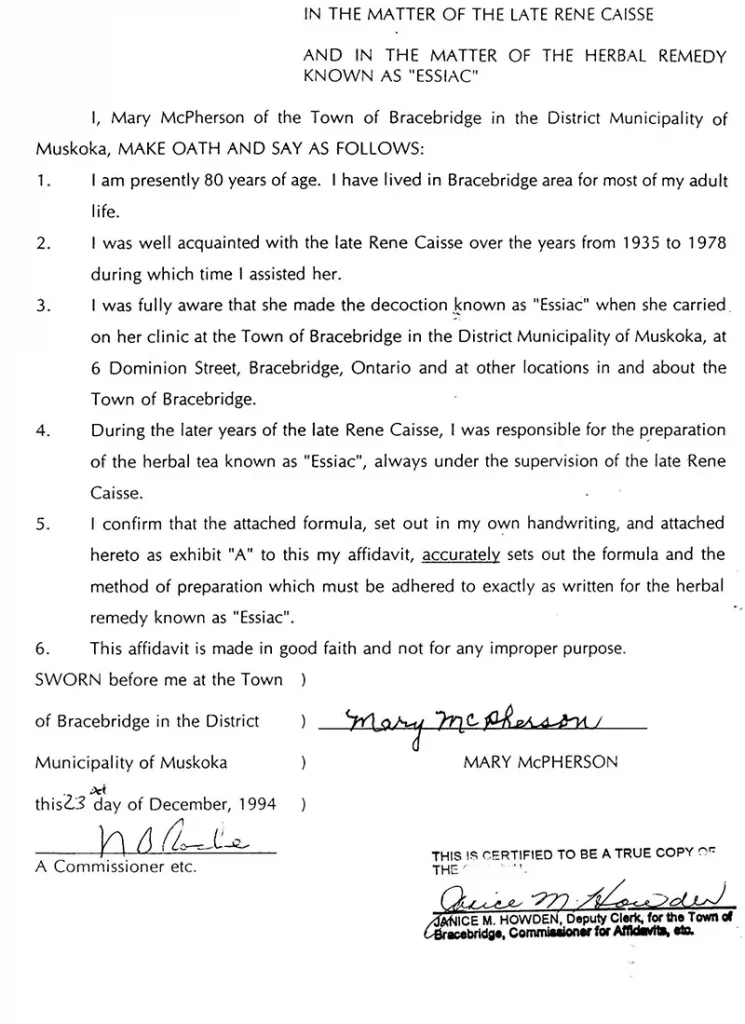
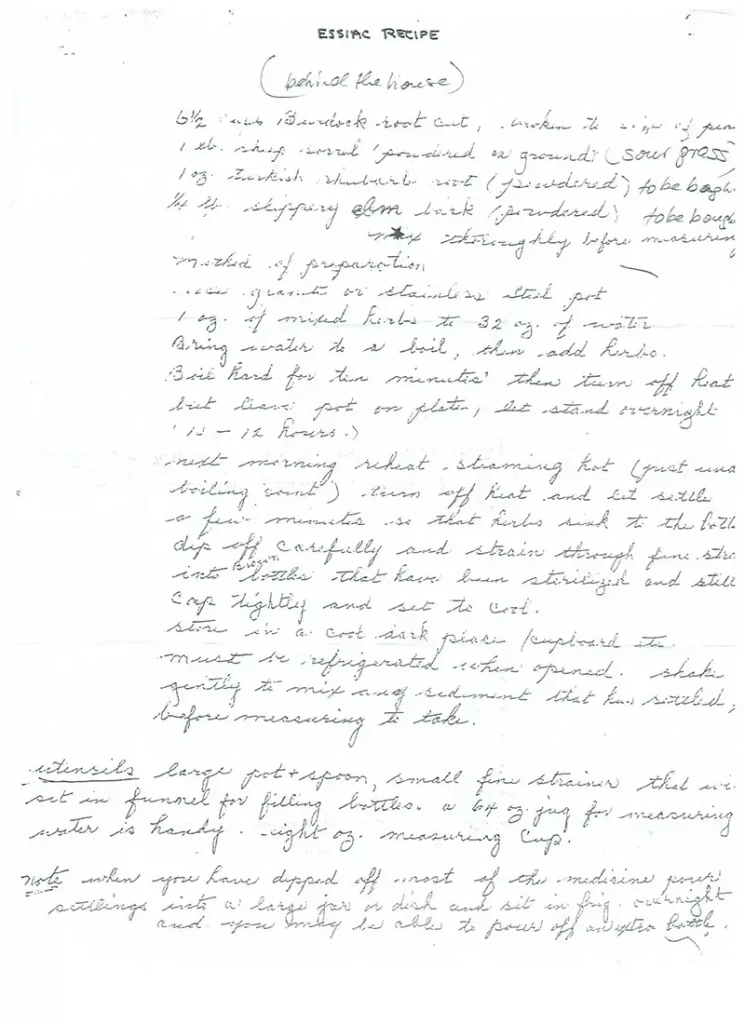
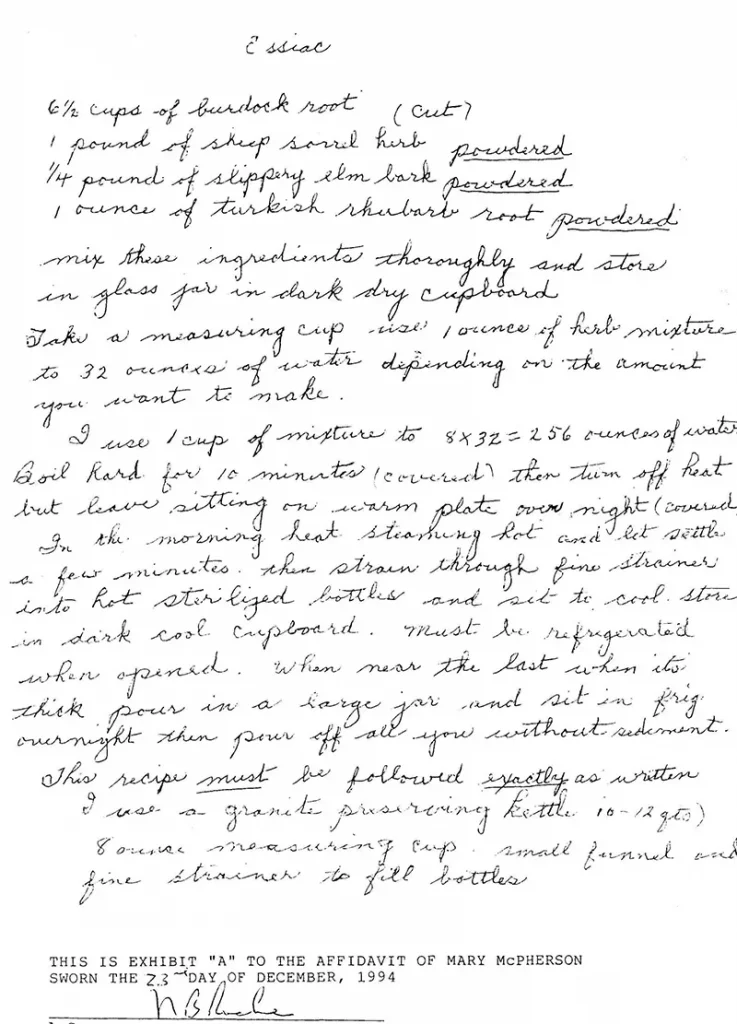
Essiac enthält eine Mischung verschiedener Kräuter, darunter Schafssauerampfer (Rumex acetosella), der sich später als der wirksamste erwies. Dann auch Glattulmen-Innenrinde (Ulmus fulva), Klettenwurzel (Arctium lappa) und Türkischer Rhabarber (Rheum palmatum).
Schlüpfrige Ulme ist das einzige in Nordamerika heimische Essiac-Kraut. Der Truthahn-Rhabarber (Rheum palmatum) stammt aus China und Tibet, nicht aus dem nördlichen Ontario, so dass es unwahrscheinlich ist, dass er Teil der ursprünglichen Kräuterrezeptur des Medizinmanns in den späten 1800er Jahren war. Es hat den Anschein, dass sowohl die Klette als auch der Schafs-Sauerampfer von frühen Siedlern aus Europa auf den Kontinent gebracht wurden, die dann ihr Wissen über diese beiden Kräuter an die örtlichen Stämme weitergaben. Klette und Sauerampfer verbreiteten sich schließlich in ganz Nordamerika, wo es genügend Wasser gab. Rene Caisse wies darauf hin, dass der Schafsklee zu den ursprünglichen Kräutern gehörte, so dass es den Anschein hat, dass der Schafsklee vor den 1890er Jahren in die "Wildnis von Nordontario" eingewandert war. Auch die Klette könnte sich bis dahin in Nordontario etabliert haben. René Caisse war der Meinung, dass der Schafs-Sauerampfer von allen Kräutern, die in ihrer Formel enthalten waren, der aktivste Krebsbekämpfer war. Dr. Chester Stock teilte diese Ansicht in Sloan-Kettering. Dr. Stock führte Mitte der siebziger Jahre über drei Jahre lang einige Studien über die Vorteile des Schafsorbers durch.
Kräuter-Volumen-Gewicht-Form-Rezept %
Klettenwurzel, erbsengroß geschnitten, 53 %.
Schafssauerampfer pulverisiert mit 36 %.
Glatte Ulmenrinde gemahlen 9 %.
Puten-Rhabarberwurzel pulverisiert 2 %.
Im Jahr 2012 wurde eine Studie in Ungarn durchgeführt. Die Ergebnisse einer Studie aus Ungarn wurden veröffentlicht und zeigten, dass das Sauerampferkraut und eine Reihe seiner Sauerampfer-Verwandten eine erhebliche Hemmwirkung auf das Zellwachstum (mindestens 50 % Hemmung der Zellproliferation) gegen eine oder mehrere Krebszelllinien zeigten.
Erzielen Sie eins für die Kräuterkundigen.
Eine im Jahr 2000 durchgeführte Umfrage ergab, dass etwa 15% der kanadischen Frauen mit Brustkrebs Essiac verwenden. Auch bei Menschen mit Immunkrankheiten wie HIV und Diabetes und als regelmäßiger Kräutertee ist Essiac sehr beliebt geworden. Einige präventive Maßnahmen bei gesundheitsbewussten Menschen. Die seit dem Tod von Caisse durchgeführten Forschungen haben einige Erkenntnisse gebracht.
Kräuter, die zur Herstellung von Essiac verwendet werden Antioxidans und krebshemmende Eigenschaften, so eine Studie des Europäischen Instituts für Onkologie. Die Ergebnisse wurden in der Märzausgabe 2006 des Journal of Ethnopharmacology veröffentlicht. Forscher fanden heraus, dass vier der Kräuter in Essiac eine natürliche Schutzwirkung gegen Krebs haben.
Schließlich kann uns eine schnelle Suche im PubMed-Archiv auf einige Studien wie (Ottenweller et al., 2004). Sie untersuchten in vitro Krebszelllinien und Milzzellen, die aus Mäusen isoliert worden waren, um die durch die Zugabe eines Essiac vermittelten Proliferationsreaktionen zu untersuchen. Sie fanden eine verminderte Proliferation sowohl der nicht krebsartigen transformierten als auch der krebsartigen Prostatazelllinie, wenn Essiac im Kulturmedium vorhanden war, was bedeutet, dass Tee die Teilung aller Zellen stoppte, aber die prozentuale Hemmung der Krebszellen war höher als die prozentuale Hemmung der regulären Zellen Dies impliziert, dass Essiac möglicherweise eine zusätzliche selektive Wirkung auf Krebszellen hat. Darüber hinaus wurde die Wirkung von Essiac in einem Immun-T-Lymphozyten-Proliferationstest gemessen. Bei niedrigen Essiac-Dosen wurde eine Zunahme der Proliferation dieser T-Zellen nachgewiesen, bei höheren Dosen wirkte Essiac jedoch hemmend auf die T-Zell-Proliferation. Dies bedeutet, dass Essiacs möglicherweise das Wachstum von Tumorzellen hemmen und gleichzeitig die Immunantwort verstärken können. Dies kann besonders bei immunsupprimierten Personen wichtig sein. Wie bei HIV.
In dieser Studie(Seely et al., 2007). Essiac zeigte signifikante Ergebnisse Antioxidans Aktivität, zeigte signifikante immunmodulatorische Wirkungen, insbesondere durch Stimulierung der Granulozyten-Phagozytose und mäßige Hemmung von Entzündungswegen. Essiac zeigte eine signifikante zellspezifische Zytotoxizität gegenüber Eierstockepithelkarzinomzellen (was bedeutet, dass es Krebs tötet). Sie kamen zu dem Schluss, dass diese Studie die erste umfassende Untersuchung der In-vitro-Wirkungen von Essiac war und dass eine In-vitro-Analyse von Essiac darauf hindeutet bedeutende antioxidative und immunmodulatorische Eigenschaftensowie eine spezifische Zytotoxizität für neoplastische Zellen (eine Zelle, die Teil eines Tumors ist) (spezifisch für die Abtötung nur von Krebszellen), was mit den historischen Eigenschaften übereinstimmt, die dieser Verbindung zugeschrieben werden. Es gibt auch andere Studien, die nichts gefunden haben und sogar eine Studie, die ein erhöhtes Brustkrebsrisiko feststellt (Kulp et al., 2006).
Wir haben es also wieder mit widersprüchlichen wissenschaftlichen Erkenntnissen zu tun. Hundert Jahre nach dem ersten Erscheinen des Essiac haben wir immer noch kein klares Bild. In einer Welt, in der angeblich jährlich Hunderte Millionen Dollar für die Krebsforschung ausgegeben werden (der Grund, warum all diese Krebsmedikamente angeblich so viel kosten), ist es irgendwie schwierig, eine einfache Teeuntersuchung und Forschung durchzuführen. Oder irgendeine andere Untersuchung für „alternative“ Heilmittel.
Die Antwort der FDA ist, dass sie diese nicht testen, weil sie Quacksalbern keine Glaubwürdigkeit geben wollen. Und das ist gelogen. Sie wollen den "Alternativen" keine Chance geben, ihre Wirksamkeit zu beweisen, denn sie sind nicht dazu da, Sie zu schützen oder zu heilen.
Sie sind dazu da, das große Pharmageschäft von Rockefeller zu schützen. Es gibt viele Fälle, die sich auf Untersuchungen des Kongresses beziehen, ich habe Essiac nur als ein Beispiel genannt. Wenn Sie wollen, können Sie die Anhörungen von Senator Paul Douglas aus Illinois von 1963 zu Krebiozen nachlesen.
Verweise:
- Ottenweller, J., Putt, K., Blumenthal, EJ, Dhawale, S. & Dhawale, SW (2004). Hemmung der Proliferation von Prostatakrebszellen durch Essiac. Zeitschrift für Alternativ- und Komplementärmedizin (New York, NY), 10(4), 687–691. https://doi.org/10.1089/acm.2004.10.687
- Seely, D., Kennedy, DA, Myers, SP, Cheras, PA, Lin, D., Li, R., Cattley, T., Brent, PA, Mills, E. & Leonard, BJ (2007). In-vitro-Analyse des pflanzlichen Wirkstoffs Essiac. Antikrebsforschung, 27(6B), 3875–3882. [PubMed]
- Kulp, KS, Montgomery, JL, Nelson, DO, Cutter, B., Latham, ER, Shattuck, DL, Klotz, DM, & Bennett, LM (2006). Die Kräutertonika Essiac und Flor-Essence stimulieren das In-vitro-Wachstum menschlicher Brustkrebszellen. Forschung und Behandlung von Brustkrebs, 98(3), 249–259. https://doi.org/10.1007/s10549-005-9156-x
Zusammenhängende Posts
Haben Sie Fragen zum Thema Ernährung und Gesundheit?
Ich würde gerne von Ihnen hören und sie in meinem nächsten Beitrag beantworten. Ich freue mich über Ihren Beitrag und Ihre Meinung und freue mich darauf, bald von Ihnen zu hören. Ich lade Sie auch dazu ein Folgen Sie uns auf Facebook, Instagram und Pinterest für weitere Inhalte zu Ernährung und Gesundheit. Sie können dort einen Kommentar hinterlassen und sich mit anderen Gesundheitsbegeisterten austauschen, Ihre Tipps und Erfahrungen teilen und Unterstützung und Ermutigung von unserem Team und unserer Community erhalten.
Ich hoffe, dass dieser Beitrag für Sie informativ und unterhaltsam war und dass Sie bereit sind, die gewonnenen Erkenntnisse anzuwenden. Wenn Sie diesen Beitrag hilfreich fanden, dann es teilen mit Ihren Freunden und Familienangehörigen, die ebenfalls davon profitieren könnten. Man weiß nie, wer auf seinem Weg zur Gesundheit vielleicht etwas Anleitung und Unterstützung braucht.
– Das könnte Ihnen auch gefallen –
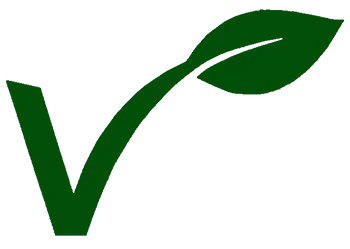
Über Ernährung Lernen
Milos Pokimica ist Doktor der Naturheilkunde, klinischer Ernährungsberater, Autor für medizinische Gesundheit und Ernährung sowie Berater für Ernährungswissenschaften. Autor der Buchreihe Zum Veganer werden? Rückblick auf die Wissenschafter betreibt auch das Natürliche Gesundheit website GoVeganWay.com
Medizinischer Haftungsausschluss
GoVeganWay.com bietet Ihnen Rezensionen der neuesten Ernährungs- und Gesundheitsforschung. Die bereitgestellten Informationen stellen die persönliche Meinung des Autors dar und sind weder als Ersatz für professionelle medizinische Beratung, Diagnose oder Behandlung gedacht noch impliziert. Die bereitgestellten Informationen dienen ausschließlich Informationszwecken und sollen nicht als Ersatz für die Beratung, Diagnose und/oder medizinische Behandlung durch einen qualifizierten Arzt oder Gesundheitsdienstleister dienen.Ignorieren Sie niemals professionellen medizinischen Rat oder verzögern Sie die Suche nach medizinischer Behandlung, weil Sie etwas auf GoVeganWay.com gelesen oder über GoVeganWay.com darauf zugegriffen haben
Nehmen Sie NIEMALS Änderungen im Lebensstil oder irgendwelche Änderungen vor, die eine Folge von etwas sind, das Sie auf GoVeganWay.com gelesen haben, bevor Sie einen zugelassenen Arzt konsultieren.
Bei einem medizinischen Notfall rufen Sie sofort einen Arzt oder die Notrufnummer 911 an. GoVeganWay.com empfiehlt oder unterstützt keine bestimmten Gruppen, Organisationen, Tests, Ärzte, Produkte, Verfahren, Meinungen oder andere Informationen, die darin erwähnt werden könnten.
Herausgeber-Tipps –
Milos Pokimica ist Autor für Gesundheit und Ernährung sowie Berater für Ernährungswissenschaften. Er ist Autor einer Buchreihe. Zum Veganer werden? Rückblick auf die Wissenschafter betreibt auch das Natürliche Gesundheit website GoVeganWay.com
Neueste Artikel –
Top-Gesundheitsnachrichten – ScienceDaily
- Why consciousness exists at allam Dezember 15, 2025
Consciousness evolved in stages, starting with basic survival responses like pain and alarm, then expanding into focused awareness and self-reflection. These layers help organisms avoid danger, learn from the environment, and coordinate socially. Surprisingly, birds show many of these same traits, from subjective perception to basic self-awareness. This suggests consciousness is far older and more widespread than once believed.
- AI found a way to stop a virus before it enters cellsam Dezember 15, 2025
Researchers discovered a hidden molecular “switch” that herpes viruses rely on to invade cells. By combining AI, simulations, and lab experiments, they identified and altered a single amino acid that shut down viral entry. What once might have taken years was achieved far faster using computational tools. The findings open new possibilities for designing future antiviral treatments.
- New study shows some plant-based diets may raise heart disease riskam Dezember 15, 2025
Researchers tracking over 63,000 adults found that high-quality, minimally processed plant foods significantly reduce cardiovascular risk. But when those plant foods are ultra-processed, the advantage disappears—and can even backfire. Some ultra-processed plant diets increased risk by 40%. The study urges a shift toward whole, naturally nutrient-rich plant foods.
- These simple habits could make your brain 8 years younger, study findsam Dezember 15, 2025
New research shows that your brain’s “true age” can shift dramatically depending on how you live, with optimism, restorative sleep, stress management, and strong social support acting like powerful anti-aging tools. Using advanced MRI-based brain-age estimates, scientists found that people with multiple healthy lifestyle factors had brains up to eight years younger than expected — even among those living with chronic pain.
- Anxiety and insomnia linked to sharp drops in key immune cellsam Dezember 15, 2025
Natural killer cells act as the immune system’s rapid-response team, but the stress of anxiety and insomnia may be quietly thinning their ranks. A study of young women in Saudi Arabia found that both conditions were linked to significantly fewer NK cells—especially the circulating types responsible for destroying infected or abnormal cells. As anxiety severity increased, NK cell levels dropped even further, suggesting a stress-driven weakening of immune defenses.
- Cannabis compounds show unexpected power against ovarian canceram Dezember 15, 2025
Scientists have discovered that key compounds from cannabis—CBD and THC—show surprisingly strong effects against ovarian cancer cells. Used together, they slow cell growth, reduce colony formation, and may even block the cancer’s ability to spread. Even more promising, the treatment caused minimal harm to healthy cells and appears to work by restoring a disrupted signaling pathway that fuels tumor growth.
- Mayo Clinic neurosurgeon reveals 8 back pain myths to stop believingam Dezember 15, 2025
Back pain is wrapped in persistent myths, but many are far from the truth. From misconceptions about heavy lifting and bed rest to confusion over posture, exercise, and surgery, Dr. Meghan Murphy breaks down what really causes pain and what actually helps. Her insights reveal that everyday habits, movement, and smart prevention often make a bigger difference than people realize.
PubMed, #Vegane Diät –
- Healthful and Unhealthful Plant-Based Diets and Their Association with Cardiometabolic Targets in Women Diagnosed with Breast Cancer: A Cross-Sectional Analysis of a Lifestyle Trialam Dezember 11, 2025
CONCLUSIONS: Maintaining cardiometabolic risk factors within normal ranges is clinically relevant in BCS, and this may be more likely when a plant-based diet is consumed, especially if low in unhealthy plant foods.
- Dietary and Lifestyle Patterns and Their Associations with Cardiovascular and Inflammatory Biomarkers in Vegans, Vegetarians, Pescatarians, and Omnivores: A Cross-Sectional Studyam Dezember 11, 2025
Background: Plant-based diets are associated with reduced cardiometabolic risk, yet the influence of lifestyle behaviors on these benefits remains insufficiently understood. Objective: To assess the combined impact of dietary patterns and lifestyle behaviors on body composition, lipid profiles, and inflammatory biomarkers in healthy young adults. Methods: In this cross-sectional study, 155 participants aged 18-39 years were categorized into four dietary groups: vegans (n = 48), vegetarians (n […]
- Functional and Nutritional Properties of Lion’s Mane Mushrooms in Oat-Based Desserts for Dysphagia and Healthy Ageingam Dezember 11, 2025
Hericium erinaceus (Lion’s Mane mushroom) is a medicinal species recognised for its neuroprotective and antioxidant properties. This study investigated its potential as a functional ingredient in oat milk-based desserts formulated for individuals with dysphagia. Freeze-dried Lion’s Mane powder (LMP), containing high-quality protein (~16%, amino acid score 88%), dietary fibre (~31%), and phenolic compounds (72.15 mg GAE/g), was incorporated at varying levels using gelatin or iota-carrageenan […]
- “A football team with no midfield”: A qualitative analysis of anti-vegan stigma in Italyam Dezember 7, 2025
A growing body of research has demonstrated the prevalence of unfavourable attitudes towards individuals who adhere to a vegan diet and has provided empirical evidence to support the existence of an anti-vegan ideology. The present study aims to contribute to extant knowledge by examining the social perception of veganism and vegans in Italy. Italy is a nation characterised by a traditional culture of food that serves as a significant catalyst for collective identification and national pride….
- Plant-based dietary index on the Mediterranean and a vegan diet: a secondary analysis of a randomized, cross-over trialam Dezember 5, 2025
CONCLUSION: These findings suggest that, replacing animal products even with the “unhealthful” plant-based foods on a vegan diet was associated with weight loss.
Zufällige Beiträge –
Beliebte Beiträge -
Neuestes von PubMed, #pflanzliche Ernährung –
- Identification of effective plant-based oils for use in aquafeed: An evaluation of impact on gamete quality and developmental success using zebrafish (Danio rerio) as a screening organismvon Seyed-Mohammadreza Samaee am Dezember 14, 2025
To evaluate the effectiveness of zebrafish as a screening system for identifying appropriate plant oils (POs) for aquafeed, Artemia nauplii (AN) were enriched with three single- cultivar olive oils (OO): Koroneiki, Parseh, and Arghavan. The resulting AN (ANKor, ANPar, ANArg, and AN36 [36 h starved AN, control]) were then fed to 360 fish (3.5 cm) for one month. The fatty acid (FA) profile of the AN was reflected in the ova and influenced both sperm motility and density, which in turn affected […]
- The Effect of Dietary Interventions on Human Vascular Function in the Context of Acute Psychological Stress: A Scoping Reviewvon Rosalind Baynham am Dezember 14, 2025
Episodes of acute psychological stress increase the risk for cardiovascular diseases, partially through stress-induced impairments in vascular function. During psychologically stressful periods, individuals are more likely to consume unhealthy foods and fewer fruits and vegetables. Yet, the impact of dietary choices and their nutritional composition on vascular function in the context of psychological stress is unclear. In this scoping review, comprehensive database searches were carried out […]
- Plant-based diets, gut microbiota, blood metabolome, and risk of colorectal, liver and pancreatic cancers: results from a large prospective cohort study of predominantly low-income Americansvon Fangcheng Yuan am Dezember 14, 2025
CONCLUSIONS: A diet high in healthy plant foods and low in animal foods was inversely associated with liver cancer risk and with CRC risk among screening-naïve participants. These associations may be partly mediated through gut microbiota and systemic metabolism.
- Vegetarian diet and likelihood of becoming centenarians in Chinese adults aged 80 years or older: a nested case-control studyvon Yaqi Li am Dezember 14, 2025
CONCLUSIONS: Targeting individuals of advanced age (80+ years) in China, we found that individuals following vegetarian diet had lower likelihood of becoming centenarians relative to omnivores, underscoring the importance of a balanced high-quality diet with animal- and plant-derived food composition for exceptional longevity, especially in the underweight oldest-old.
- Priority of nutrition and exercise in depression management: triangulating mini-review of past and recent evidence with clinical practice guidelinesvon Shannon Rogers am Dezember 14, 2025
CONCLUSIONS: Disparities that exist in leading depression management guidelines vis-à-vis inclusion of evidence-informed nutrition and PA/PE recommendations, warrant reconciliation. Evidence supporting anti-depressant WFPB nutrition and limiting pro-inflammatory animal-sourced food and UPF and supporting anti-inflammatory aerobic exercise and resistance training warrants being translated into national/international depression management guidelines as consistently as recommendations for…
- The effect of a diet based on vegetable and dairy protein on biochemical and functional indicators of sarcopenia in patients with liver cirrhosis: a randomized controlled trialvon Mahdiyeh Taghizadeh am Dezember 13, 2025
CONCLUSIONS: In conclusion, a vegetable and dairy protein-based diet effectively inhibited significant elevations in ammonia levels compared to the standard diet in persons with liver cirrhosis; however, anthropometric parameters and muscle function did not differ between two groups.
